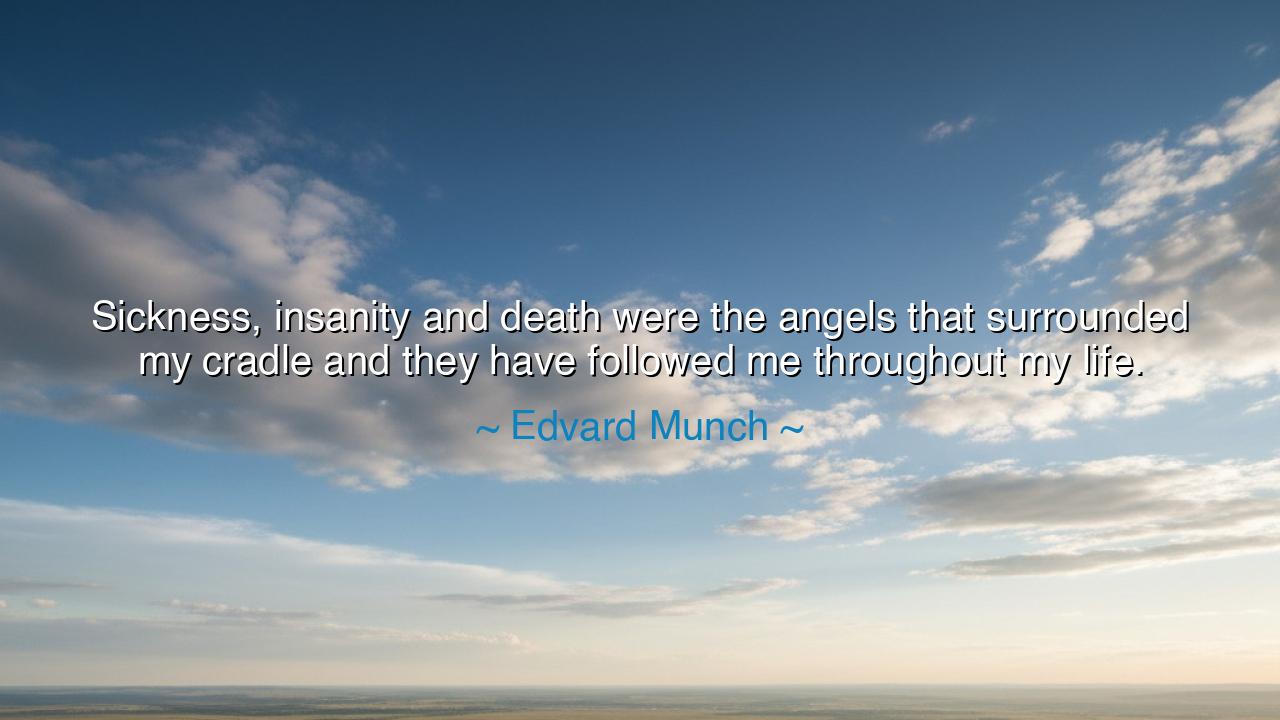
Sickness, insanity and death were the angels that surrounded my
Sickness, insanity and death were the angels that surrounded my cradle and they have followed me throughout my life.






"Sickness, insanity and death were the angels that surrounded my cradle and they have followed me throughout my life." — thus confessed Edvard Munch, the tormented painter whose art bled with the colors of anguish and eternity. These words are not mere lamentation, but a revelation — a glimpse into the soul of a man who saw beauty and terror intertwined from his earliest breath. In this haunting declaration, Munch acknowledges that suffering, though cruel, was his lifelong companion and teacher. The three “angels” — sickness, insanity, and death — were not curses to him, but forces that carved depth into his vision and meaning into his art.
The meaning of this quote lies in the paradox of life’s dual nature — that creation often grows from pain, and understanding from despair. Munch’s “angels” are not holy in the conventional sense; they are grim and merciless, yet they guard him as guides of the spirit. He was surrounded from infancy by loss and frailty — his mother died of tuberculosis when he was five, and his beloved sister followed soon after. His father, a pious man, suffered from anxiety and instability, and the shadow of illness hung perpetually over the household. To Munch, this darkness became the natural rhythm of existence. He did not flee it — he painted it. Out of fear, he forged immortality. Out of torment, he birthed truth.
The origin of these words can be traced to the life and vision of Edvard Munch, the Norwegian master of expressionism. His art, most famously “The Scream,” is a mirror of his inner world — trembling with dread, loneliness, and spiritual awe. He painted as one haunted by ghosts, because he was. The deaths in his family, the sickness that stalked his youth, and his own fragile mind fused into a creative fire that could not be extinguished. When he spoke of being followed by these “angels,” he meant that he could never escape the presence of mortality — it was the muse whispering behind every brushstroke. Yet it was this constant confrontation with pain that made his art pulse with the heartbeat of humanity itself.
History has known others who, like Munch, found greatness through suffering. Vincent van Gogh, his spiritual twin, battled madness and despair, yet transformed agony into light. His paintings, like Munch’s, were hymns of the soul crying out through color. Both men lived on the edge of sanity, their spirits stretched between heaven and earth. Their pain did not destroy them — it consecrated them. The ancients would have understood this, for in their eyes, the artist was often a prophet — one who walks through fire to bring back light for others. And so it was with Munch: his angels of sorrow were his eternal companions, but also his eternal source of truth.
There is a strange holiness in his perspective. To call sickness, insanity, and death “angels” is to transform suffering into meaning. In doing so, Munch teaches us that even our most painful experiences can be guides toward wisdom. The body may tremble, the mind may fracture, but the spirit — when it endures — becomes luminous. The saints of old fasted and suffered to purify their souls; the poets and painters of the modern age endured emotional storms for the same reason. Through suffering, they pierced the veil between the seen and the unseen. Munch’s angels, though dark, brought him closer to the eternal.
Yet, his words also warn us. To be followed by such angels is both a blessing and a burden. For not all who meet despair find creation — many are broken by it. What saved Munch was his expression — his willingness to pour his fear into art rather than silence. His life reveals a universal truth: when the soul cannot escape pain, it must transform it. Those who turn inward in their suffering and make from it something beautiful — a painting, a poem, an act of kindness — conquer what would otherwise destroy them. In this way, pain becomes not punishment, but purification.
The lesson for us, then, is this: do not curse the shadows that walk beside you. The same darkness that frightens can also awaken the light within. When hardship enters your life — be it sickness, loss, or despair — remember that these are not your enemies, but your teachers. Face them as Munch did: not with denial, but with creation, with honesty, with courage. Speak through your pain; do not let it silence you. For in every human life, the angels of suffering hover close — but it is through their fire that the soul learns to shine.
And so, remember the wisdom of Edvard Munch, the painter who turned agony into immortality: to live is to be haunted, but to create is to be free. The angels that surround your cradle will follow you through life — but whether they destroy you or transform you depends on whether you choose to fear them, or to let them teach you how to paint your own soul upon the canvas of the world.






AAdministratorAdministrator
Welcome, honored guests. Please leave a comment, we will respond soon